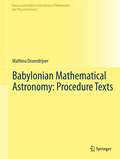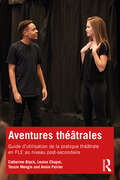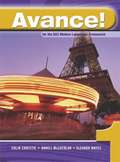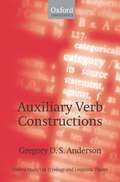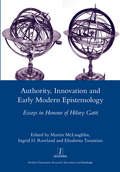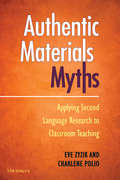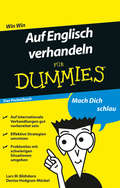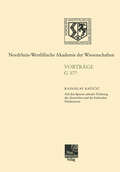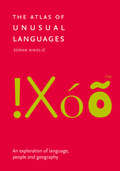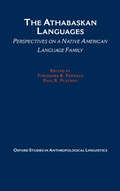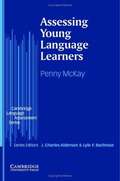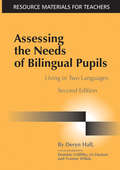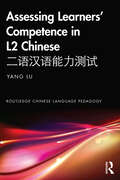- Table View
- List View
Babylonian Mathematical Astronomy: Procedure Texts (Sources and Studies in the History of Mathematics and Physical Sciences)
by Mathieu OssendrijverThis book contains new translations and a new analysis of the procedure texts of Babylonian mathematical astronomy, the earliest known form of mathematical astronomy of the ancient world. The translations are based on a modern approach incorporating recent insights from Assyriology and translation science. The work contains updated and expanded interpretations of the astronomical algorithms and investigations of previously ignored linguistic, mathematical and other aspects of the procedure texts. Special attention is paid to issues of mathematical representation and over 100 photos of cuneiform tablets dating from 350-50 BCE are presented.In 2-3 years, the author intends to continue his study of Babylonian mathematical astronomy with a new publication which will contain new editions and reconstructions of approx. 250 tabular texts and a new philological, astronomical and mathematical analysis of these texts. Tabular texts are end products of Babylonian math astronomy, computed with algorithms that are formulated in the present volume, Procedure Texts.
Aventures théâtrales: Guide d’utilisation de la pratique théâtrale en FLE au niveau post-secondaire
by Catherine Black Louise Chaput Tessie Mengin Annie PoirierAventures théâtrales est un guide pratique destiné aux enseignants de FLE désirant incorporer le théâtre dans leur cours afin de développer les compétences orales et de communication. Le livre s’articule autour de quatre parties : un bref historique des origines de l’utilisation du théâtre dans l’enseignement, une partie consacrée à la prononciation dans un contexte dramatique avec de nombreux exercices, un répertoire d’activités séquencées menant à la production de A à Z d’une pièce de théâtre ; la dernière partie montre que, même à distance, dans un contexte virtuel, il est possible de faire du théâtre et d’établir des liens émotionnels entre les participants. Le livre propose aussi une exploration unique du théâtre audio par le biais de pièces radiophoniques, de podcasts (baladodiffusions) et de videocasts (vidéodiffusions). Qu’elles soient en présentiel ou à distance, les activités présentées dans cet ouvrage constituent un ensemble de ressources indispensables à ceux et celles voulant tenter l’aventure théâtrale même sans expérience. Aventures théâtrales vise le niveau B2 du CECRL (Cadre européen commun de référence pour les langues) ou le niveau intermédiaire de ACTFL (American Consortium for the Teaching of Foreign Languages). Aventures théâtrales is a practical guide designed to provide language instructors with the tools to use drama in French language courses, providing essential resources to develop learners’ communication skills through drama activities in the classroom. This book is structured around four axes: The origins of the use of theatre in teaching; the pronunciation of French adapted to dramatic activities; a repertoire of activities leading to the production from A to Z of a show; and the digital adventure: establishing an emotional and energetic connection between participants in a virtual setting. The book also offers a unique exploration of audio theatre, from radio plays to podcasts, with guidance on practical applications outside of the classroom setting. The remote and in person exercises included in this book are an invaluable resource for instructors. Aventures théâtrales is intended for instructors of French at B2 (CEFR) or intermediate (ACTFL) level interested in using drama in courses teaching French as a foreign or second language.
Aventures théâtrales: Guide d’utilisation de la pratique théâtrale en FLE au niveau post-secondaire
by Catherine Black Louise Chaput Tessie Mengin Annie PoirierAventures théâtrales est un guide pratique destiné aux enseignants de FLE désirant incorporer le théâtre dans leur cours afin de développer les compétences orales et de communication. Le livre s’articule autour de quatre parties : un bref historique des origines de l’utilisation du théâtre dans l’enseignement, une partie consacrée à la prononciation dans un contexte dramatique avec de nombreux exercices, un répertoire d’activités séquencées menant à la production de A à Z d’une pièce de théâtre ; la dernière partie montre que, même à distance, dans un contexte virtuel, il est possible de faire du théâtre et d’établir des liens émotionnels entre les participants. Le livre propose aussi une exploration unique du théâtre audio par le biais de pièces radiophoniques, de podcasts (baladodiffusions) et de videocasts (vidéodiffusions). Qu’elles soient en présentiel ou à distance, les activités présentées dans cet ouvrage constituent un ensemble de ressources indispensables à ceux et celles voulant tenter l’aventure théâtrale même sans expérience. Aventures théâtrales vise le niveau B2 du CECRL (Cadre européen commun de référence pour les langues) ou le niveau intermédiaire de ACTFL (American Consortium for the Teaching of Foreign Languages). Aventures théâtrales is a practical guide designed to provide language instructors with the tools to use drama in French language courses, providing essential resources to develop learners’ communication skills through drama activities in the classroom. This book is structured around four axes: The origins of the use of theatre in teaching; the pronunciation of French adapted to dramatic activities; a repertoire of activities leading to the production from A to Z of a show; and the digital adventure: establishing an emotional and energetic connection between participants in a virtual setting. The book also offers a unique exploration of audio theatre, from radio plays to podcasts, with guidance on practical applications outside of the classroom setting. The remote and in person exercises included in this book are an invaluable resource for instructors. Aventures théâtrales is intended for instructors of French at B2 (CEFR) or intermediate (ACTFL) level interested in using drama in courses teaching French as a foreign or second language.
Avanzando: Gramatica espanola y lectura
by Carmen Salazar Rafael Arias Sara L. de la VegaPrecise grammar explanations, engaging readings, and a flexible organization are just a few reasons why Avanzando: gramática española y lectura, Seventh Edition, is so effective in high-intermediate to advanced Spanish courses both for heritage and non-heritage student. Featuring a new thematic approach that exposes students to current topics, Avanzando continues to offer a comprehensive look at Spanish grammar. The flexible organization of the text, which has been tested and refined through six highly successful editions, encourages students to build on their current Spanish language skills and learn more advanced grammar points while developing their cultural knowledge and critical thinking skills, all in Spanish.The clear grammar explanations and thorough practice activities are complemented by engaging, theme-based readings in each chapter in Part I, and a selection of short stories by well-known Spanish and Latin American authors in Part II. Reading activities encourage close reading and analysis of the texts, and are designed to develop critical thinking skills and to generate class discussion.
Avance: Framework French
by Anneli Mclachlan Colin Christie Eleanor MayesAvance is an exciting new French course that makes teaching with the Key Stage 3 Languages Framework straightforward and enjoyable. Written by a very experienced team of teachers, Avance 1 provides a perfect start for learners of French of all abilities.
Auxiliary Verb Constructions (Oxford Studies In Typology And Linguistic Theory Ser.)
by Gregory D. S. AndersonThis is the most comprehensive survey ever published of auxiliary verb constructions, as in 'he could have been going to drink it' and 'she does eat cheese'. Drawing on a database of over 800 languages Dr Anderson examines their morphosyntactic forms and semantic roles. He investigates and explains the historical changes leading to the cross-linguistic diversity of inflectional patterns, and he presents his results within a new typological framework. The book's impressive range includes data on variation within and across languages and language families. In addition to examining languages in Africa, Europe, and Asia the author presents analyses of languages in Australasia and the Pacific and in North, South, and Meso-America. In doing so he reveals much that is new about the language families of the world and makes an important contribution to the understanding of their nature and evolution. His book will interest scholars and researchers in language typology, historical and comparative linguistics, syntax, and morphology.
Autoethnography in Language Education: Tensions, Characteristics, and Methods
by Bedrettin YazanThis book presents an exploration of autoethnography in language education research as a qualitative method with the potential to decolonize language education practices and include marginalized scholars in knowledge generation. The author situates the method of autoethnography within the field, arguing that it has taken too long for autoethnography to be considered an established research method in language education in particular and in educational research in general. He then addresses tensions at the macro and micro levels of autoethnography, discusses its characteristics, and describes the processes and procedures involved in conducting autoethnographic research. This book will be of interest to graduate students and scholars in language education and related disciplines such as anthropology, communication studies, sociology, and broader educational research.
Authority, Innovation and Early Modern Epistemology: Essays in Honour of Hilary Gatti
by Martin McLaughlinGiordano Bruno (1548-1600), who died at the stake, is one of the best-known symbols of anti-establishment thought. The theme of this volume, which is offered as a collection of essays to honour the distinguished Bruno scholar Hilary Gatti, reflects her constant concern for the principles of cultural freedom and independent thinking. Several essays deal with Bruno himself, including an analysis of the Eroici furori, a study of his reception in relation to the group known as the Novatores, and discussions of several important aspects of his stay in England. The authors and texts discussed here are linked by a relentless interest in the question of authority and originality, and they range from literary figures such as Alberti (1404-72), Vasari (1511-74) and the proponents of quantitative verse in sixteenth-century England to controversial philosophers who, like Bruno, were condemned by the Church, such as Tommaso Campanella (1568-1639) and Giulio Cesare Vanini (1585-1619). Taken together, these chapters show how much that was new and revolutionary in early modern culture came from its confrontation with the past. Martin McLaughlin is Agnelli-Serena Professor of Italian at Oxford. Elisabetta Tarantino is a Teaching Fellow in the Department of Italian at the University of Warwick.
Authority, Innovation and Early Modern Epistemology: Essays in Honour of Hilary Gatti
by Martin McLaughlinGiordano Bruno (1548-1600), who died at the stake, is one of the best-known symbols of anti-establishment thought. The theme of this volume, which is offered as a collection of essays to honour the distinguished Bruno scholar Hilary Gatti, reflects her constant concern for the principles of cultural freedom and independent thinking. Several essays deal with Bruno himself, including an analysis of the Eroici furori, a study of his reception in relation to the group known as the Novatores, and discussions of several important aspects of his stay in England. The authors and texts discussed here are linked by a relentless interest in the question of authority and originality, and they range from literary figures such as Alberti (1404-72), Vasari (1511-74) and the proponents of quantitative verse in sixteenth-century England to controversial philosophers who, like Bruno, were condemned by the Church, such as Tommaso Campanella (1568-1639) and Giulio Cesare Vanini (1585-1619). Taken together, these chapters show how much that was new and revolutionary in early modern culture came from its confrontation with the past. Martin McLaughlin is Agnelli-Serena Professor of Italian at Oxford. Elisabetta Tarantino is a Teaching Fellow in the Department of Italian at the University of Warwick.
Authentic Materials Myths: Applying Second Language Research to Classroom Teaching
by Eve Zyzik Charlene PolioThe use of authentic materials in language classrooms is sometimes discussed as a reliable way to expose students to the target language, but there is also disagreement regarding what kinds of authentic materials should be used, when they should be used, and how much of the curriculum should revolve around them. This volume in the Myths series explores the research related to the use of authentic materials and the ways that authentic materials may be used successfully in the classroom. Like others in the Myths series, this book combines research with good pedagogical practices. The myths examined in this book are: Authentic texts are inaccessible to beginners. Authentic texts cannot be used to teach grammar. Shorter texts are more beneficial for language learners. Activating background knowledge or making a word list is sufficient to prepare students for authentic texts. Authentic texts can be used to teach only listening and reading. Modifying or simplifying authentic texts always helps language learners. For learners to benefit from using authentic texts, the associated tasks must also be authentic. The Epilogue explores the challenges of using authentic texts in the classroom and calls for more research.
Australian English Reimagined: Structure, Features and Developments (Routledge Studies in World Englishes)
by Louisa Willoughby Howard MannsAustralian English is perhaps best known for its colourful slang, but the variety is much richer than slang alone. This collection provides a detailed account of Australian English by bringing together leading scholars of this English variety. These scholars provide a comprehensive overview of Australian English’s distinctive features and outline cutting-edge research into the variation and change of English in Australia. Organised thematically, this volume explores the ways in which Australian English differs from other varieties of English, as well as examining regional, social and stylistic variation within the variety. The volume first explores particular structural features where Australian English differentiates itself from other English varieties. There are chapters on phonetics and phonology, socio-phonetics, lexicon and discourse-pragmatics as these elements are core to understanding any variety of English, especially within the World Englishes paradigm. It then considers what are arguably the most salient aspects of variation within Australian English and finally focuses on historical, attitudinal and planning aspects of Australian English. This volume provides a thorough account of Australian English and its users as complex, diverse and worthy of study. Perhaps more importantly, this volume’s scholars provide a reimagining of Australian English and the paradigm through which future scholars may proceed.
Australian English Reimagined: Structure, Features and Developments (Routledge Studies in World Englishes)
by Louisa Willoughby Howard MannsAustralian English is perhaps best known for its colourful slang, but the variety is much richer than slang alone. This collection provides a detailed account of Australian English by bringing together leading scholars of this English variety. These scholars provide a comprehensive overview of Australian English’s distinctive features and outline cutting-edge research into the variation and change of English in Australia. Organised thematically, this volume explores the ways in which Australian English differs from other varieties of English, as well as examining regional, social and stylistic variation within the variety. The volume first explores particular structural features where Australian English differentiates itself from other English varieties. There are chapters on phonetics and phonology, socio-phonetics, lexicon and discourse-pragmatics as these elements are core to understanding any variety of English, especially within the World Englishes paradigm. It then considers what are arguably the most salient aspects of variation within Australian English and finally focuses on historical, attitudinal and planning aspects of Australian English. This volume provides a thorough account of Australian English and its users as complex, diverse and worthy of study. Perhaps more importantly, this volume’s scholars provide a reimagining of Australian English and the paradigm through which future scholars may proceed.
Auf Englisch verhandeln fur Dummies Das Pocketbuch (Für Dummies)
by Dr. Lars M. Blöhdorn Denise Hodgson-MöckelNicht jeder, der souverän und erfolreich eine Verhandlung führen kann, fühlt sich auch im Umgang mit englischsprachigen Verhandlungspartnern sicher. Lars M. Blöhdorn und Denise Hodgson-Möckel geben Ihnen die wichtigsten Vokabeln und Redewendungen für Verhandlungen auf Englisch an die Hand. Die Autoren verraten Ihnen auch, wie sie so manche Klippe bei schwierigen Verhandlungen umschiffen können. So können Sie gelassen und gut vorbereitet Ihrer nächsten Verhandlung auf Englisch entgegensehen.
Auf den Spuren sakraler Dichtung des slawischen und des baltischen Heidentums: 440. Sitzung am 18. Juli 2001 in Düsseldorf (Nordrhein-Westfälische Akademie der Wissenschaften)
by Radoslav KatiĉićThe Atlas of Unusual Languages: An Exploration Of Language, People And Geography
by Zoran Nikolic Collins BooksWe communicate through the spoken and written word and language has evolved over the centuries. Many languages have survived although only in small pockets throughout the world. This book explores a selection of those languages.
Atlas of the World's Languages
by R. E. Asher Christopher MoseleyBefore the first appearance of the Atlas of the World's Languages in 1993, all the world's languages had never been accurately and completely mapped. The Atlas depicts the location of every known living language, including languages on the point of extinction. This fully revised edition of the Atlas offers: up-to-date research, some from fieldwork in early 2006 a general linguistic history of each section an overview of the genetic relations of the languages in each section statistical and sociolinguistic information a large number of new or completely updated maps further reading and a bibliography for each section a cross-referenced language index of over 6,000 languages. Presenting contributions from international scholars, covering over 6,000 languages and containing over 150 full-colour maps, the Atlas of the World's Languages is the definitive reference resource for every linguistic and reference library.
Atlas of the World's Languages
by R. E. Asher and Christopher MoseleyBefore the first appearance of the Atlas of the World's Languages in 1993, all the world's languages had never been accurately and completely mapped. The Atlas depicts the location of every known living language, including languages on the point of extinction. This fully revised edition of the Atlas offers: up-to-date research, some from fieldwork in early 2006 a general linguistic history of each section an overview of the genetic relations of the languages in each section statistical and sociolinguistic information a large number of new or completely updated maps further reading and a bibliography for each section a cross-referenced language index of over 6,000 languages. Presenting contributions from international scholars, covering over 6,000 languages and containing over 150 full-colour maps, the Atlas of the World's Languages is the definitive reference resource for every linguistic and reference library.
The Athabaskan Languages: Perspectives on a Native American Language Family (Oxford Studies in Anthropological Linguistics)
by Theodore Fernald Paul PlateroThe Native American language family called Athabaskan has received increasing attention from linguists and educators. The linguistic chapters in this volume focus on syntax and semantics, but also involve morphology, phonology, and historical linguistics. Included is a discussion of whether religion and secular issues can be separated in Navajo classrooms.
Assessing Young Language Learners (PDF)
by Penny McKay Lyle F. Bachman J. Charles AldersonIn this book the author builds a comprehensive framework for the assessment of young language learners in both foreign language and second language learning situations. She begins by considering why we need a special book on young learner assessment, and describes the nature of young learner language learning. The assessment approach is task-based and is centred around tasks and techniques suitable for young learners, with particular emphasis on classroom assessment. Oral language assessment, and reading and writing assessment are addressed in separate chapters, as is the large-scale testing of young learners. Underpinned by sound theory, the book is full of practical guidelines, and draws on examples of assessment contexts, issues and practices from around the world. Assessing Young Language Learners was winner of the Kenneth W Mildenberger Prize in 2006.
Assessing the Needs of Bilingual Pupils: Living in Two Languages (PDF)
by Deryn Hall Dominic Griffiths Liz Haslam Yvonne WilkinEver since its publication in 1995, this book has offered a means for teachers to consider why some bilingual pupils in their classrooms are not making learning progress or are academically underachieving. This new second edition has been revised and updated in the light of the new government legislation and guidance, most significantly the revised Code of Practice for Special Educational Needs. It continues to look at ways of asking questions about the pupil, of collecting evidence of both learning and language development and of offering support within the classroom. It contains a model and photocopiable proformas for use within schools, which should help to establish clear systems of identification of those bilingual pupils who may have special learning needs and to distinguish these from the need for language support.
Assessing the Needs of Bilingual Pupils: Living in Two Languages
by Deryn Hall Dominic Griffiths Liz Haslam Yvonne WilkinEver since its publication in 1995, this book has offered a means for teachers to consider why some bilingual pupils in their classrooms are not making learning progress or are academically underachieving. This new second edition has been revised and updated in the light of the new government legislation and guidance, most significantly the revised Code of Practice for Special Educational Needs. It continues to look at ways of asking questions about the pupil, of collecting evidence of both learning and language development and of offering support within the classroom. It contains a model and photocopiable proformas for use within schools, which should help to establish clear systems of identification of those bilingual pupils who may have special learning needs and to distinguish these from the need for language support.
Assessing Learners’ Competence in L2 Chinese 二语汉语能力测试 (Routledge Chinese Language Pedagogy)
by Yang LuAssessing Learners’ Competence in L2 Chinese is the first book intended to answer the question on whether existing standardised and classroom-based assessments can reflect learners’ competence in L2 Chinese. The Chinese language has enjoyed increasing global popularity amongst second/foreign language learners and has become one of the major modern languages for school and university curricula. However, to many teachers and researchers, it has been difficult to answer with confidence whether the existing standardised and classroom tests can reflect learners’ competence in L2 Chinese. This book defines and redefines the constructs for assessing L2 Chinese competence that have been overlooked or misplaced because of the unique features of the Chinese language. The book provides theoretical backgrounds and practical methodologies for assessing competence in L2 Chinese trainees and experienced teachers of Chinese as a second language. It will provide invaluable guidelines and ready-made workshop materials for postgraduate teacher training programmes. Researchers and academics will find innovative frameworks on the subject for further studies and debates.
Assessing Learners’ Competence in L2 Chinese 二语汉语能力测试 (Routledge Chinese Language Pedagogy)
by Yang LuAssessing Learners’ Competence in L2 Chinese is the first book intended to answer the question on whether existing standardised and classroom-based assessments can reflect learners’ competence in L2 Chinese. The Chinese language has enjoyed increasing global popularity amongst second/foreign language learners and has become one of the major modern languages for school and university curricula. However, to many teachers and researchers, it has been difficult to answer with confidence whether the existing standardised and classroom tests can reflect learners’ competence in L2 Chinese. This book defines and redefines the constructs for assessing L2 Chinese competence that have been overlooked or misplaced because of the unique features of the Chinese language. The book provides theoretical backgrounds and practical methodologies for assessing competence in L2 Chinese trainees and experienced teachers of Chinese as a second language. It will provide invaluable guidelines and ready-made workshop materials for postgraduate teacher training programmes. Researchers and academics will find innovative frameworks on the subject for further studies and debates.
Assessing L2 Digital Multimodal Composing Competence (Routledge Focus on Applied Linguistics)
by Emily Di Zhang Shulin YuThis book focuses on assessing L2 student digital multimodal composing (DMC) competence. It explores key themes, including the conceptualization of L2 student DMC competence, and the development, validation, and utilization of L2 student DMC competence in the tertiary context.Through a thorough review of the DMC literature, the book furnishes readers with a theoretical framework to comprehensively grasp the underlying constructs of L2 student DMC competence. It also provides a delineation of the process of scale development, i.e., defining constructs, constructing items, and analyzing items, scale validation, i.e., the structural, external, and consequential construct validity of the scale, and scale utilization in students’ DMC self- and peer-assessment practices.This practical guidance equips educators and practitioners with the necessary tools and strategies to effectively assess and enhance L2 students’ DMC competence. Scholars and professionals in the fields of L2 writing, language assessment, digital literacy, and technology-enhanced language learning will gain valuable insights from the content.
Assessing L2 Digital Multimodal Composing Competence (Routledge Focus on Applied Linguistics)
by Emily Di Zhang Shulin YuThis book focuses on assessing L2 student digital multimodal composing (DMC) competence. It explores key themes, including the conceptualization of L2 student DMC competence, and the development, validation, and utilization of L2 student DMC competence in the tertiary context.Through a thorough review of the DMC literature, the book furnishes readers with a theoretical framework to comprehensively grasp the underlying constructs of L2 student DMC competence. It also provides a delineation of the process of scale development, i.e., defining constructs, constructing items, and analyzing items, scale validation, i.e., the structural, external, and consequential construct validity of the scale, and scale utilization in students’ DMC self- and peer-assessment practices.This practical guidance equips educators and practitioners with the necessary tools and strategies to effectively assess and enhance L2 students’ DMC competence. Scholars and professionals in the fields of L2 writing, language assessment, digital literacy, and technology-enhanced language learning will gain valuable insights from the content.
